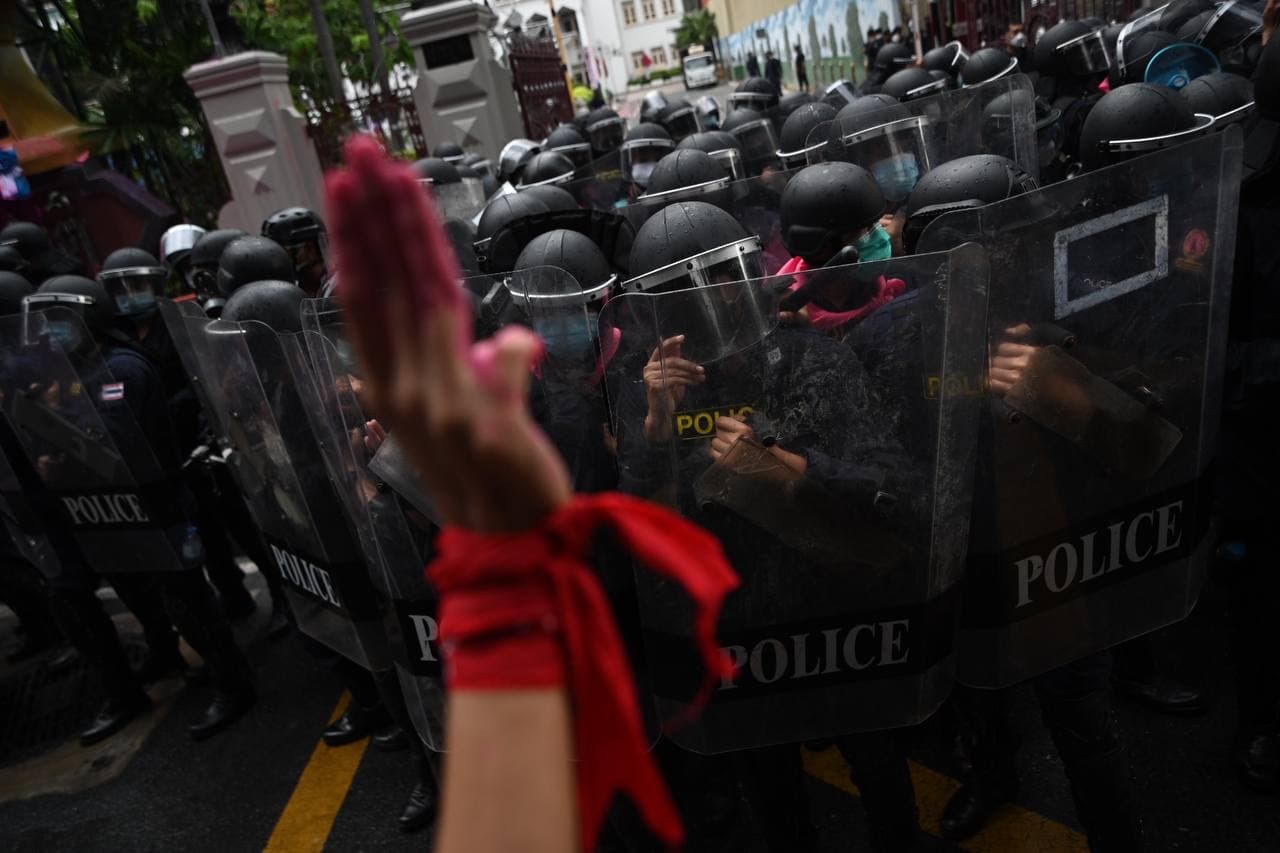Overview of the public assemblies
The organizers, venues, timing, approximate number of participants of public assemblies, number of policing officials
During 16-22 August 2021, the week was teeming with a series of public assemblies following the first week of August. Nevertheless, there were only two key organizing groups, one of which was the Thalu Fah (Thalu Fah Village) which has been organized political activities and mobilizations to demand the ouster of General Prayut Chan-ocha from the premiership due to his utter failure regarding economic management and response to the Covid-19 pandemic. A variety of activities were organized, and they moved to various locations including the private residence of General Prayut Chan-ocha, the Government House, the Democracy Monument, at least three embassies, and the Office of the United Nations High Commissioner for Human Rights. Another key group is the Thalugaz Youth, a group of freelancers who have converged at the Samliam Din Daeng Intersection since early August. After 20 August 2021, they have reorganized and started calling themselves Thalugaz Youth with the emblem on white flag. The youth group share their demands with the Thalu Fah, although their background, ages and preferred venue of public assemblies as well as the nature of their activism are different from other groups. In sum, they are children and youth from 11-20 years who are gathered on their motorcycles to form a motorcade. Facing restriction from the public officials, they would respond using equipment such as slingshots, bead balls, big firecrackers and others and hurling them at the crowd control officials. They also destroyed some public property such as the vandalization of police box on Din Daeng Rd., or their setting fire on the road where they were gathered. Overall, the youth were gathered themselves every day and it has taken place over 20 times since early August 2021. These children and youth have become the largest group of participants arrested, held in custody and charged for offences concerning public assemblies later.

16 August 2021 public assembly organized by the Thalu Fah group at the Victory Monument, Bangkok. Photo by Mob Data Thailand
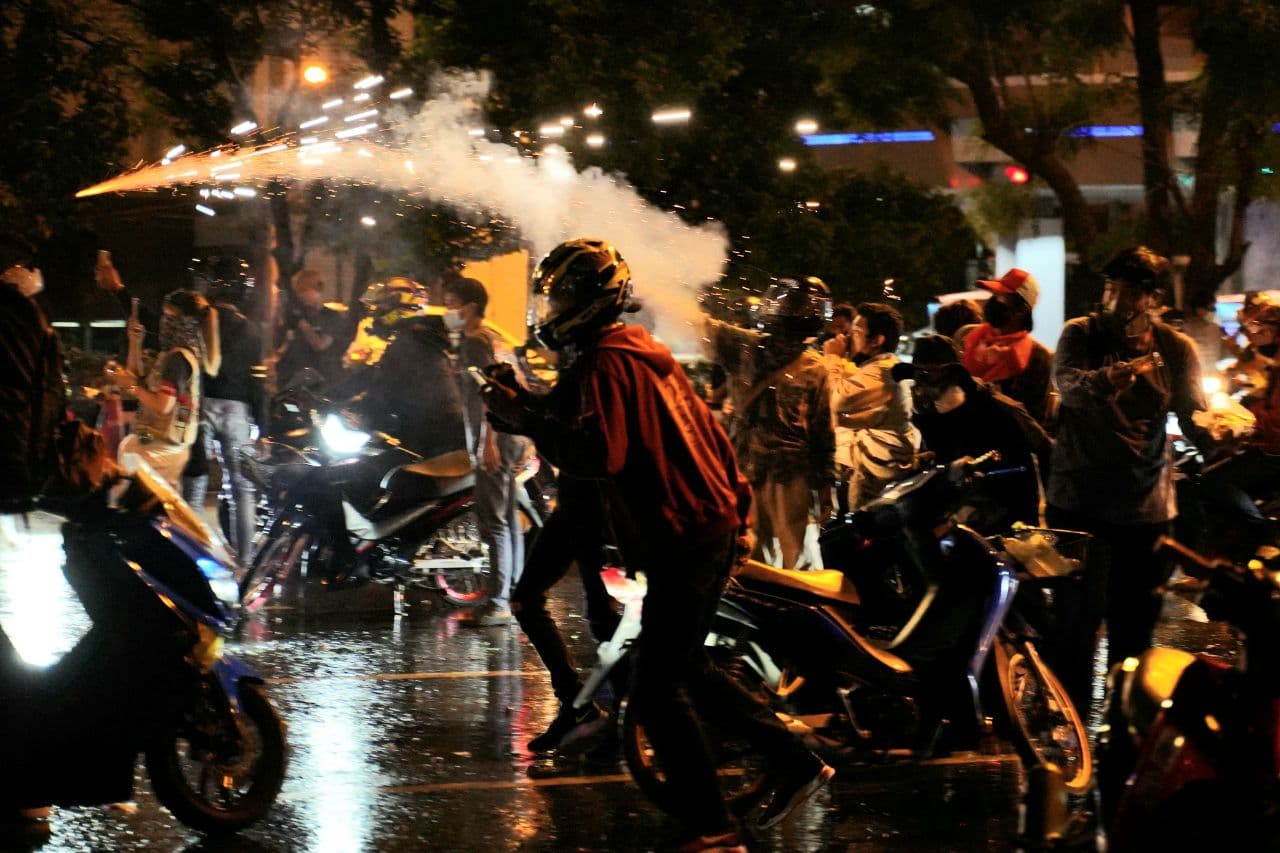
21 August 2021 public assembly organized by the Thalugaz group at Din Daeng intersection , Bangkok. Photo by Mob Data Thailand
How the force has been used by officials to stop public assemblies, the number and examples of injuries and persons held in custody including children and youth, the press, observers (if any)
On 21 August 2021, the Royal Thai Police has removed ship containers from Vibhavadi Rangsit Rd. They used to be deployed there to block the procession of the participants who wanted to reach to the private residence of the Prime Minister. Still, Amnesty International Thailand has found the crowd control officials continued to use increasing violence to arrest and hold in custody the participants including the use of less-lethal weapons including water cannon, firearms to fire rubber bullets and other weapons of each crowd control official. This has led to a large number of casualties. They also started to fire water cannon laced with tear gas in close range at the participants, and used cable tires to restrain arrested children and youth for a longer period of time. They also failed to ensure the injured persons receive prompt medical attention. In addition, containment has been adopted as part of the tactic for public assembly dispersal by cordoning off and arresting the participants. This method was used on 22 August 2021 to arrest as many as 42 participants at the Samliam Din Daeng Intersection including 19 children and youth from 25 public assemblies. The number of arrestees has surged to 63 during 16-22 August 2021.
In addition, AIT has found that the presence of media and monitors had significant and swaying impact on the use of force to disperse the public assemblies. With the strong presence of media to livestream the events and with monitors at the public assemblies, the officials would incline to not use force to conduct the widespread arrests or apprehension. On the contrary, with the weak presence of media or monitors at the public assemblies, they would tend to use more forces to carry out the arrests of the participants. They also tended to tell the press later that the participants had first used violence against them.
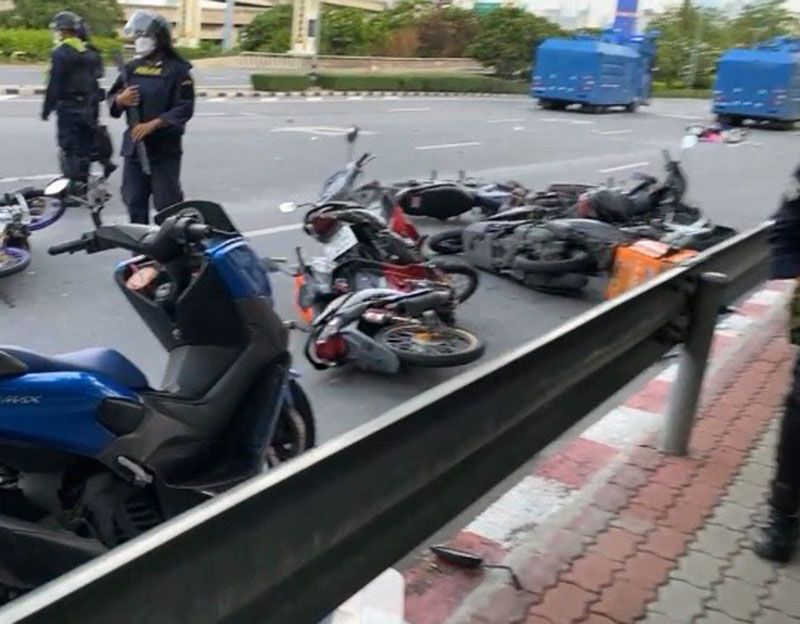
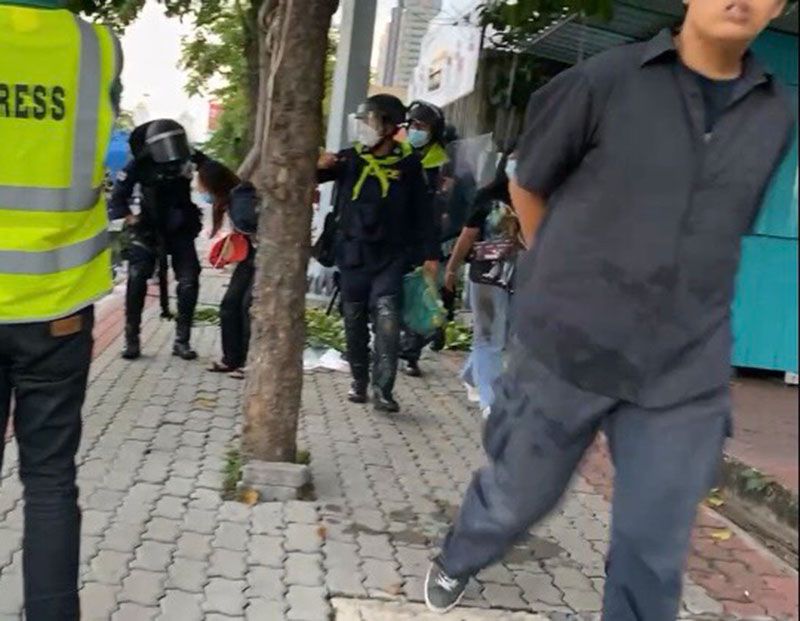
The dispersal of the Thalugas group's rally on 22 August 2021 at Din Daeng Intersection, Bangkok. Photo by Naewna
Nature of public assembly dispersal and suppression
How policing forces are deployed, the interval between the announcement and the dispersal of public assemblies, legal provisions invoked to state the alleged offences which have been used as a reason to demand restriction of public assemblies
It clearly states in the General Comment no. 37 that kettling or containment can only be adopted where it is necessary and proportionate to do so, in order to address actual violence or an imminent threat emanating from that section. Specific efforts must be made to contain, as far as possible, only people linked directly to violence and to limit the duration of the containment to the minimum necessary. Where containment is used indiscriminately or punitively, it violates the right of peaceful assembly, and may also violate other rights such as freedom from arbitrary detention and freedom of movement.
Nevertheless, AIT has found that the crowd control officials tend to resort more to the use of containment after the formation of the Thalugaz Youth claiming it is part of the kettling tactic to clear the way for rapid units to charge in and arrest the participants. It was starkly clear during the public assembly on 22 August 2021. AIT has found the tactic was used to carry out a mass arrest of youth present there and it has led to the arrests of even non-participants including commuters or residents in the area. The use of force during the arrests has led to injuries including physical abuse at the neck, head, occipital, chest, being harshly pulled by arms, being harshly pulled by collars, being restrained from the back, being tasered on torso, being pressed on neck and back, being forced to lay flat on the ground, being hit with truncheons, etc. Some participants said they were kicked and punched in his face until he passed out. Some others were handcuffed or had their hands restrained by cable tires. And some were hit with rubber bullets. It indicates how such containment tactic was used indiscriminately and punitively, the act of which constitutes a violation of the right to freedom of peaceful assembly and possibly other rights as well including freedom from arbitrary arrest and freedom of movement of non-participants.
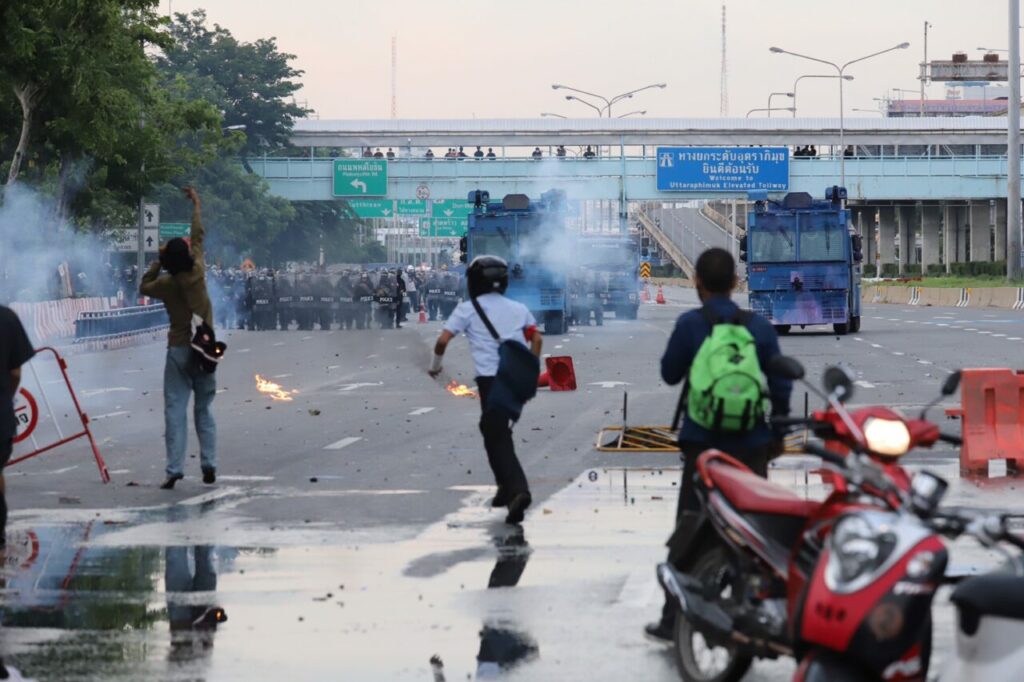

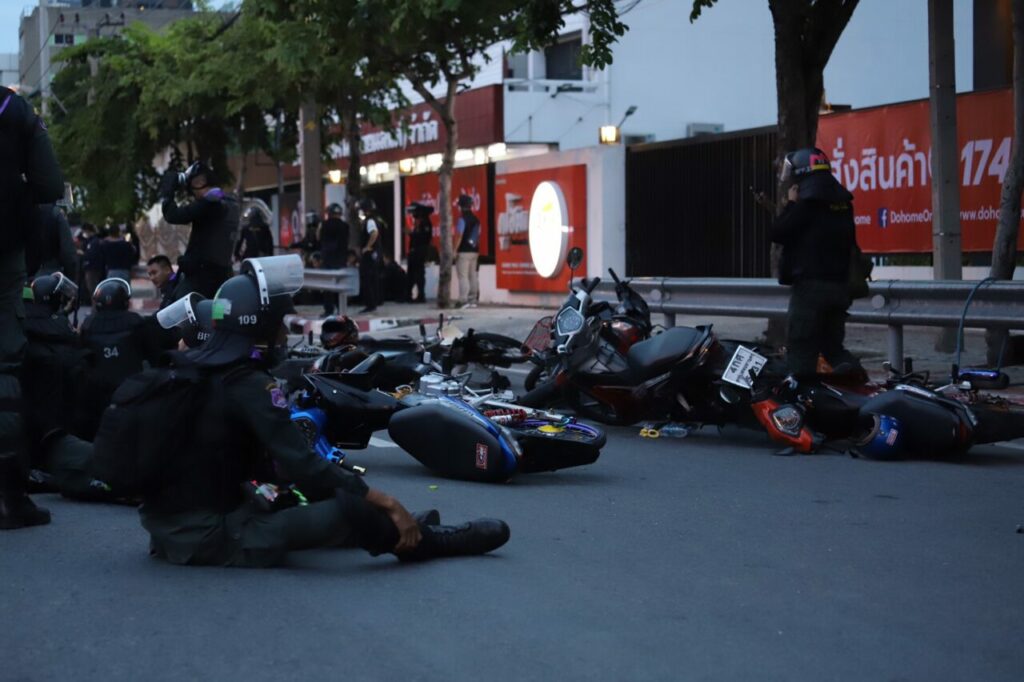
The dispersal of the Thalugas group's rally on 22 August 2021 at Din Daeng Intersection, Bangkok. Photo by Dailynews
In addition, according to the UN Human Rights Committee’s General Comment no. 37, it emphasizes that public assembly dispersal should be used only as a measure of last resort if the assembly as such is no longer peaceful, or if there is clear evidence of an imminent threat of serious violence that cannot be reasonably addressed by more proportionate measures. Nevertheless, in reality, there was no indication that the officials have adhere to such order of operation. They simply announced that the gathering of the participants was deemed ‘illegal’ or ‘contravene the Emergency Decree on Public Administration in the State of Emergency’, and then started to disperse the public assemblies. They often started from firing water cannon laced with tear gas at the participants and firing rubber bullets in close range and then arrested the injured persons or those who were physically unable to run away as they got injured from the use of such equipment. In addition, arrests have often been carried out even without any violence, i.e., the dance of the participants in front of the Headquarters of the Royal Thai Police has led to the arrest of a dozen of participants on 17 August 2021.
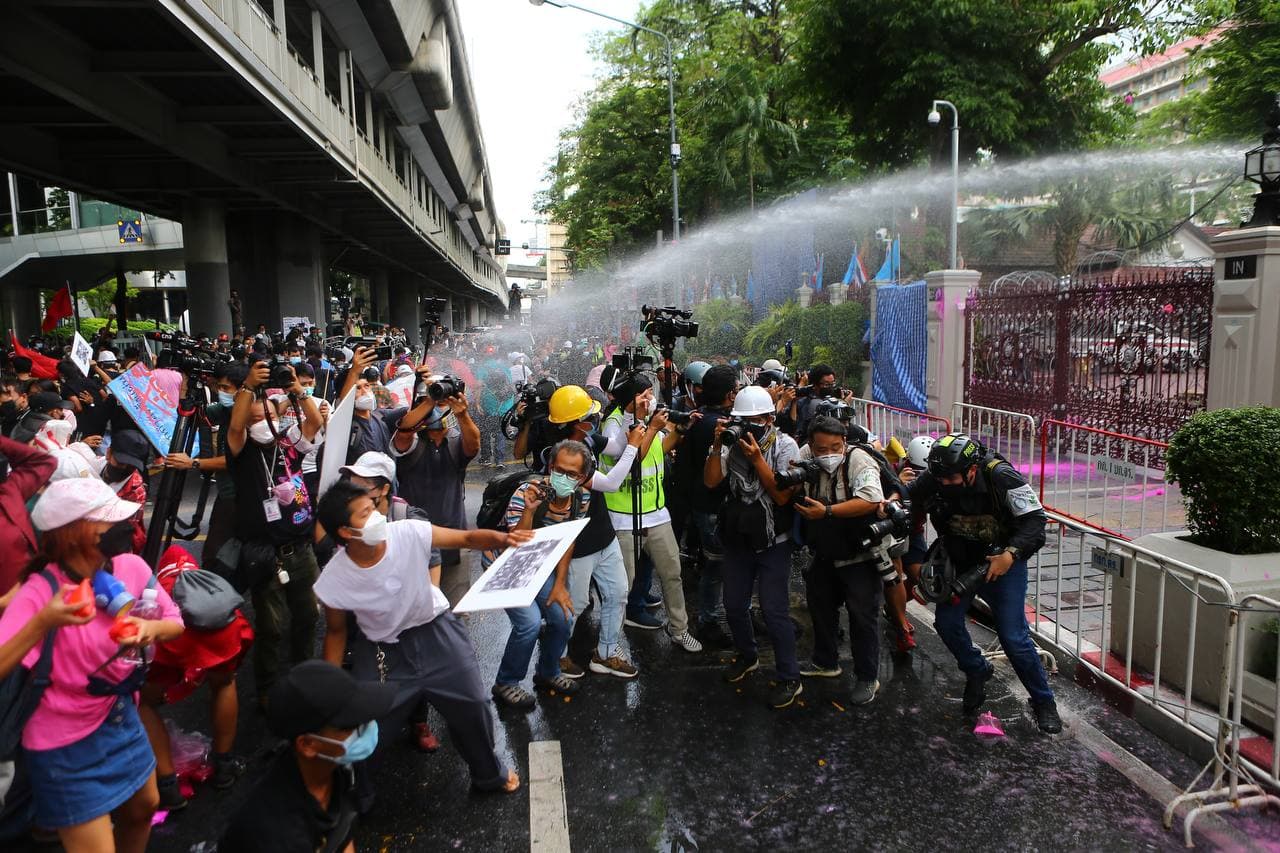
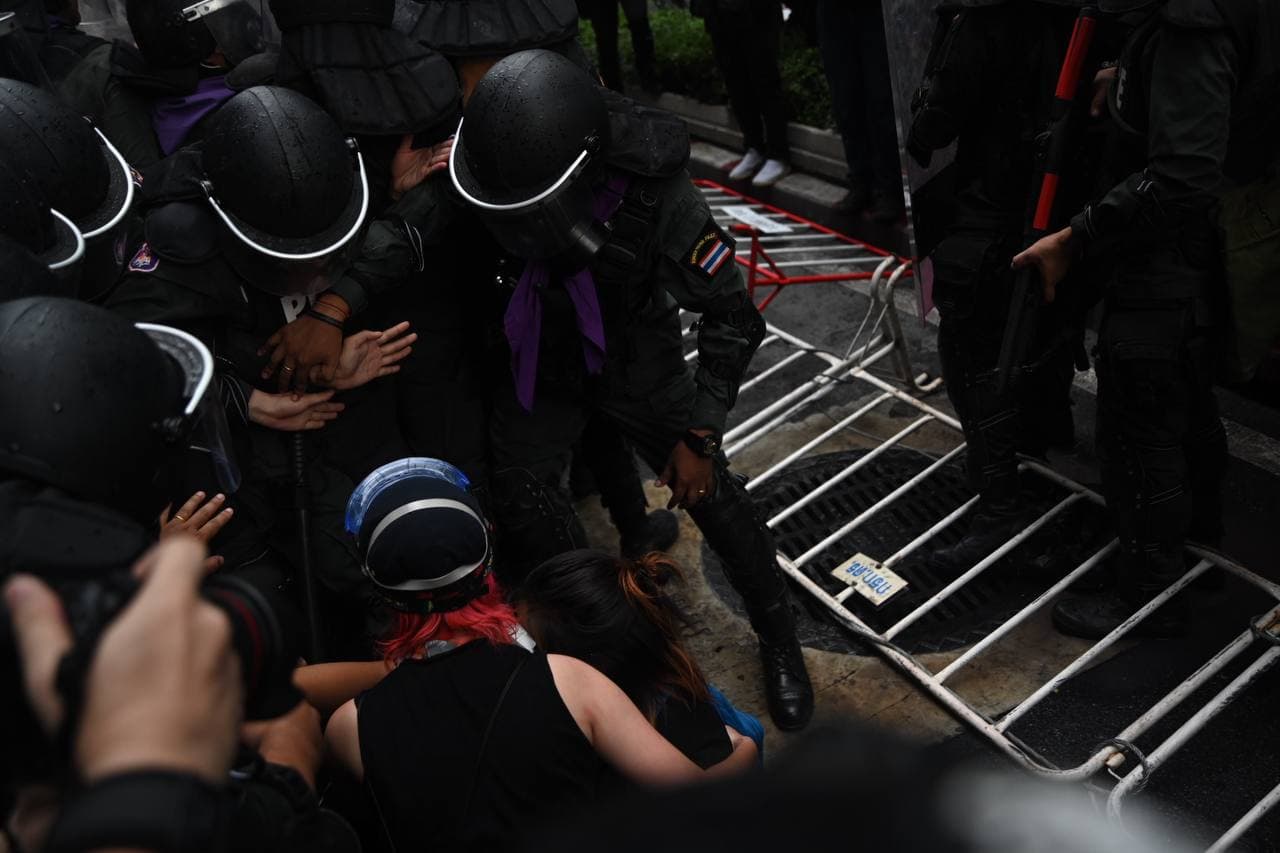
The dispersal of the public assembly organized by the Thalu Fah group on 17 August 2021 from Ratchaprasong Intersection to the Royal Thai Police Office, Bangkok. Photo by Mob Data Thailand
Has there been restriction of public assemblies? If so, what kinds of methods/equipment have been used? For example, during the public assembly on 7 August, ship containers and old oil drums were used.
Has there been a search or seizure of equipment from any particular groups of participants in a public assembly?
The police have removed ship containers from Vibhavadi Rangsit Rd. since 21 August 2021 as it was used as a tactic to restrict public assemblies by the crowd control officials. Since then, the crowd control officials have adopted containment and started more to arrest the participants, particularly children and youth at the Samliam Din Daeng Intersection since they often drove motorcycles and used the vehicles as part of their public assemblies. Such motorcycles have often been subject to a search and seizure as well as their mobile phones during the arrests and detention. The officials conducting the seizure including crowd control officials who made the arrests and the inquiry officials who read to them the arrest reports or the charges against them. In addition, passersby in Samliam Din Daeng Intersection have often been stopped for search and a 20-year-old man was charged after he was found to have in possession slingshots and bead balls under his motorcycle’s saddle, While being arrested, held in custody and answered to the charges, he was not accompanied by his attorneys.

16 August 2021 public assembly organized by the Thalu Fah group at Victory Monument, Bangkok. Photo by Mob Data Thailand
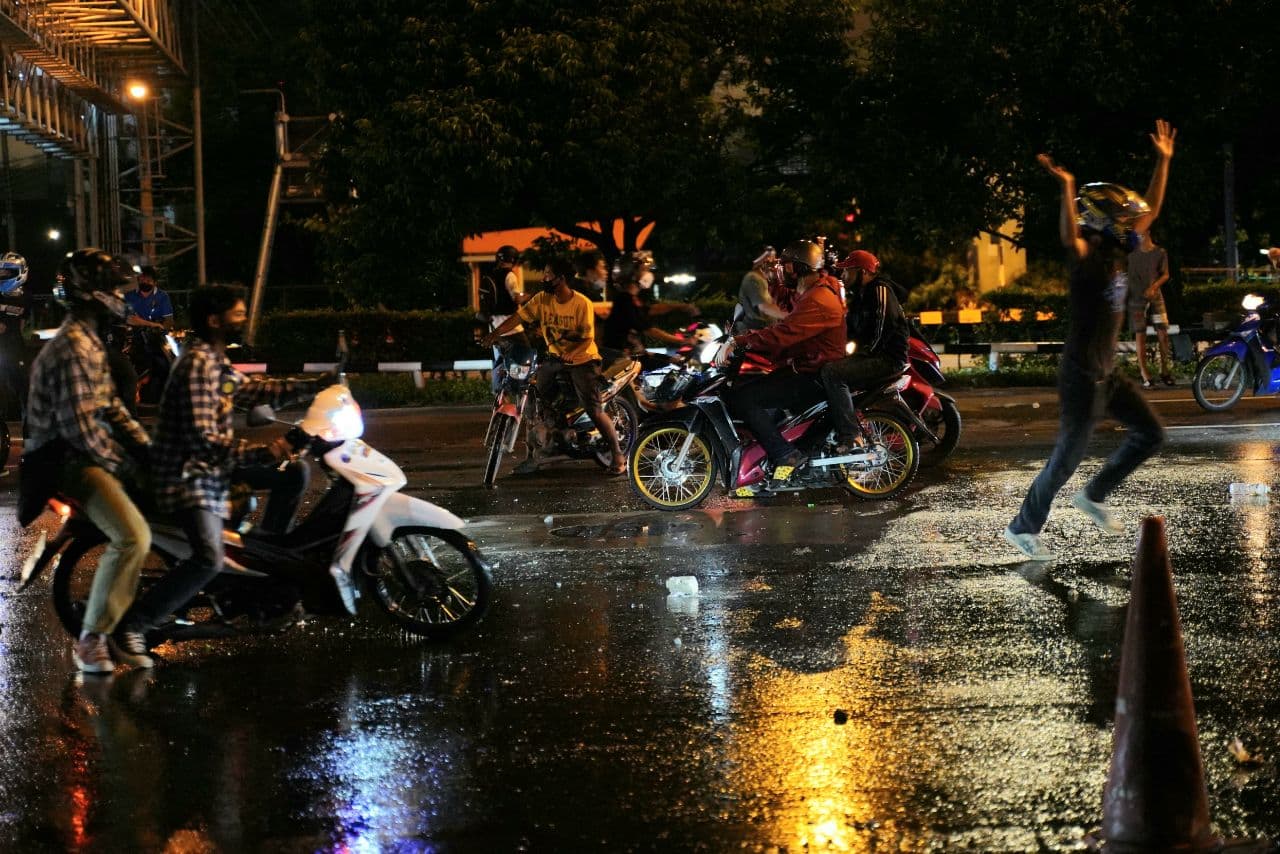
21 August 2021 public assembly organized by the Thalugaz group at Din Daeng intersection , Bangkok. Photo by Mob Data Thailand
The use of arms and equipment by the officials during the public assembly dispersal and suppression including water cannon, tear gas, rubber bullets
The Guidance on Less-Lethal Weapons in Law Enforcement, 2020, of the ICCPR and other international standards adopted by UN Human Rights Institutions, it can be summarized that;
Water cannon
Water cannon should only be used in situations of serious public disorder “where there is a significant likelihood of loss of life, serious injury or the widespread destruction of property”. In order to meet the requirements of necessity and proportionality, the deployment of water cannon should be carefully planned and should be managed with rigorous command and control at a senior level.
Tear gas
Tear gas can be launched from a distance at groups of individuals engaged in violent acts. The aim of using chemical irritants dispersed at a distance is usually to cause the members of the group to disperse and to refrain from violence. In such circumstances, they should be fired at a high angle. Tear gas should not be aimed at a person and whatever circumstance, it shall not fired at the face since it may cause fatal risk to life and body.
Rubber bullets
The equipment can be used in response to the acts of throwing or hurling of objects including the use of rubber bullets, plastic bullets, impact rounds, baton rounds or bean bags which can only be used against "persons who commit violence." It should be fired with the aim of striking the lower abdomen or legs of a violent individual and only with a view to addressing “an imminent threat of injury to either a law enforcement official or a member of the public." Targeting the face or head may result in skull fracture and brain injury, damage to the eyes, including permanent blindness, or even death. Kinetic impact projectiles should not be fired in automatic mode. Multiple projectiles fired at the same time are inaccurate and, in general, their use cannot comply with the principles of necessity and proportionality.
The interval between the officials’ announcement and public assembly dispersal, the order of the weapons and equipment for public assembly dispersal, how the weapons and equipment are used against the protests, the distance, the trajectory and the targets, the number of injuries and description (if any)
Even though international human rights principles do not state clearly the interval between the announcement to disband a public assembly and the public assembly dispersal, but according to General Comment no. 37 concerning the use of less-lethal weapons. The equipment (tear gas, hydrant including water cannon truck, firearms including those used to fire rubber bullets) should be used only as a measure of last resort, ‘following a verbal warning, and with adequate opportunity given for assembly participants to disperse’. And in principle, a public assembly dispersal or the use of force to disband a public assembly should be done in compliance with the requirements of lawfulness, necessity, proportionality, reservation, and non-discrimination. In other word, the officials are prohibited from using force to arbitrarily disperse a public assembly. Therefore, such safeguard is provided in Section 21 of the Public Assembly Act 2015 which allows the police or other policing officials to use their discretion subject to the review of the court.
Nevertheless, since the imposition of the Emergency Decree on Public Administration in the State of Emergency 2005 for over one year and five months, the Public Assembly Act has been suspended and all of its requirements are temporarily not applicable to the officials policing a public assembly. In reality, the officials insisted and announced that such gatherings or public assemblies were illegal and even claimed such gatherings were in violation of the Emergency Decree on Public Administration in the State of Emergency 2005, after which they would disperse the public assemblies with the use of water cannon laced with tear gas, the firing of rubber bullets and tear gas to immediately quell the gathering of the participants or to conduct containment and arrested, particularly at the Samliam Din Daeng Intersection where the Thalugaz Youth converged. Water cannon was fired straight at the participants during the containment to clear the way for the rapid units to arrest the participants.
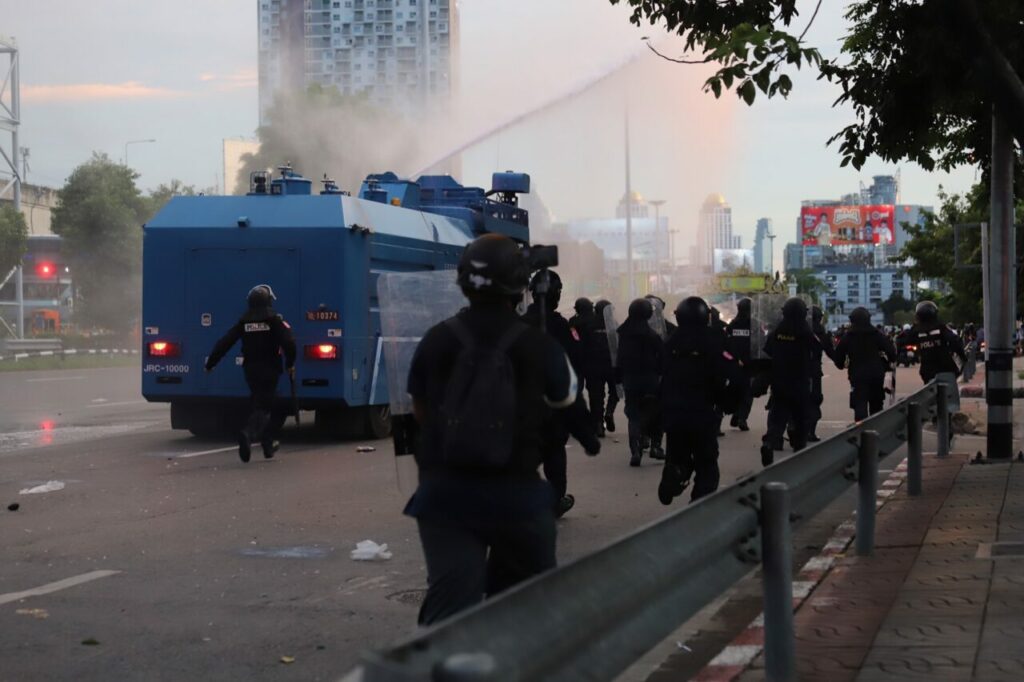
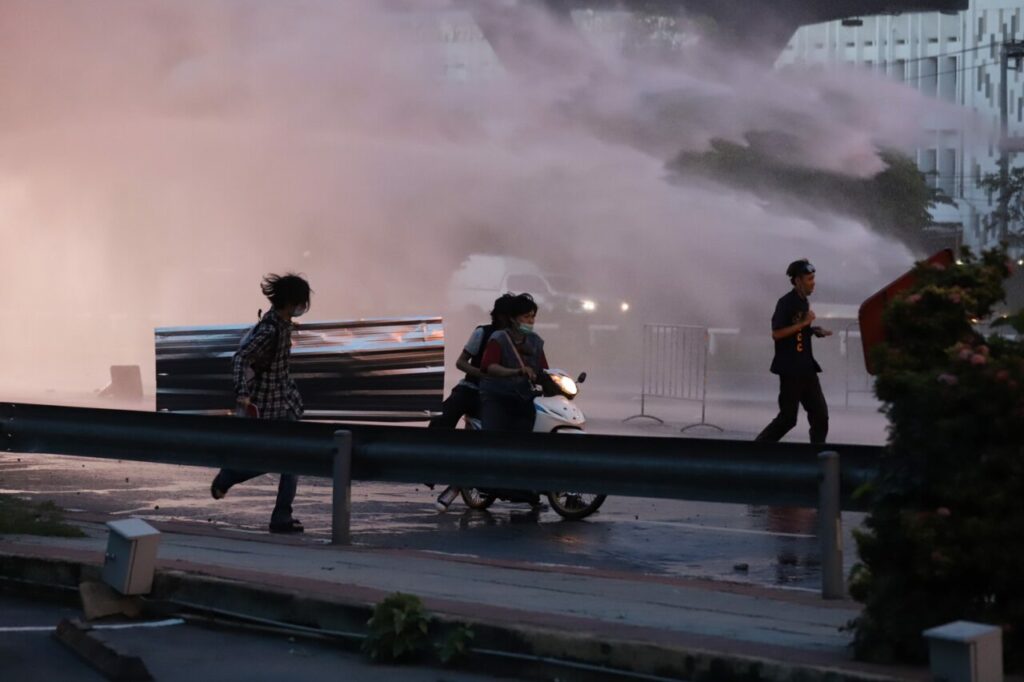
The dispersal of the Thalugas group's rally on 22 August 2021 at Din Daeng Intersection, Bangkok. Photo by Dailynews
Regarding such procedure, even though the organizers or the participants failed to adhere to some domestic requirements concerning public assembly including the Emergency Decree on Public Administration in the State of Emergency, but such act of the participants shall not deprive them of the protection according to Article 21 of the ICCPR. The fact that an assembly provokes or may provoke a hostile reaction from members of the public against participants, as a general rule, does not justify restriction of such public assemblies.
In addition, General Comment no. 37 clearly states that only the officials who have received training on crowd control and international human rights standards are allowed to carry out the policing. This stans contrary to the information collected by Mob Data Thailand’s volunteers which indicates that on 21 August 2021 when five participants were arrested from the Samliam Din Daeng Intersection, one of them was physically abused by crowd control officials, after which he had his hands wrapped with cable tires and brought into a prisoner transport vehicle. The same suspect was also hit with a truncheon in his ribs by a crowd control official who said to him that ‘You have done this to my colleagues!’ It indicates how the officials acted out of arbitrariness and personal vengeance and used for against the participants.
As to the conditions which may justify a public assembly dispersal, as said, the Public Assembly Act was suspended, there was thus no clarity as to what conditions would precede a public assembly dispersal. Lately, the authorities did not even refer to ‘violence’ originated from the participants, but simply claimed that a public gathering and assembly was a violation of the Emergency Decree on Public Administration in the State of Emergency and instantly proceeded to disperse the public assemblies without giving the participants time to call off their public assemblies or without resorting to a more proportionate measure. In AIT’s opinion, the existing domestic law does not provide a succinct condition which justifies a public assembly dispersal. Meanwhile, the police simply sanctioned a public assembly dispersal by merely claiming that the participants have violated the Emergency Decree. The claim made by the officials did not deprive the participants of the protection enshrined in Article 21 of the ICCPR. Also, water cannon, rubber bullets and tear gas, albeit considered less-lethal weapons, may cause widespread impacts. In addition, even though it has been emphasized time and again that rubber bullets should not be used for crowd control, now, they have been used as a priority, instead of a last resort after some verbal warning and ‘being given adequate opportunity to disperse’. The rubber bullets were not used to target just particular persons and were not used with strict necessity where there is ‘an imminent threat of death or serious injury’. Instead, the rubber bullets were fired continuously or semi-automatically and were fired even against passersby even it did not appear that the persons intended to cause any harm to any person. Such response by theก officials was therefore unlawful.

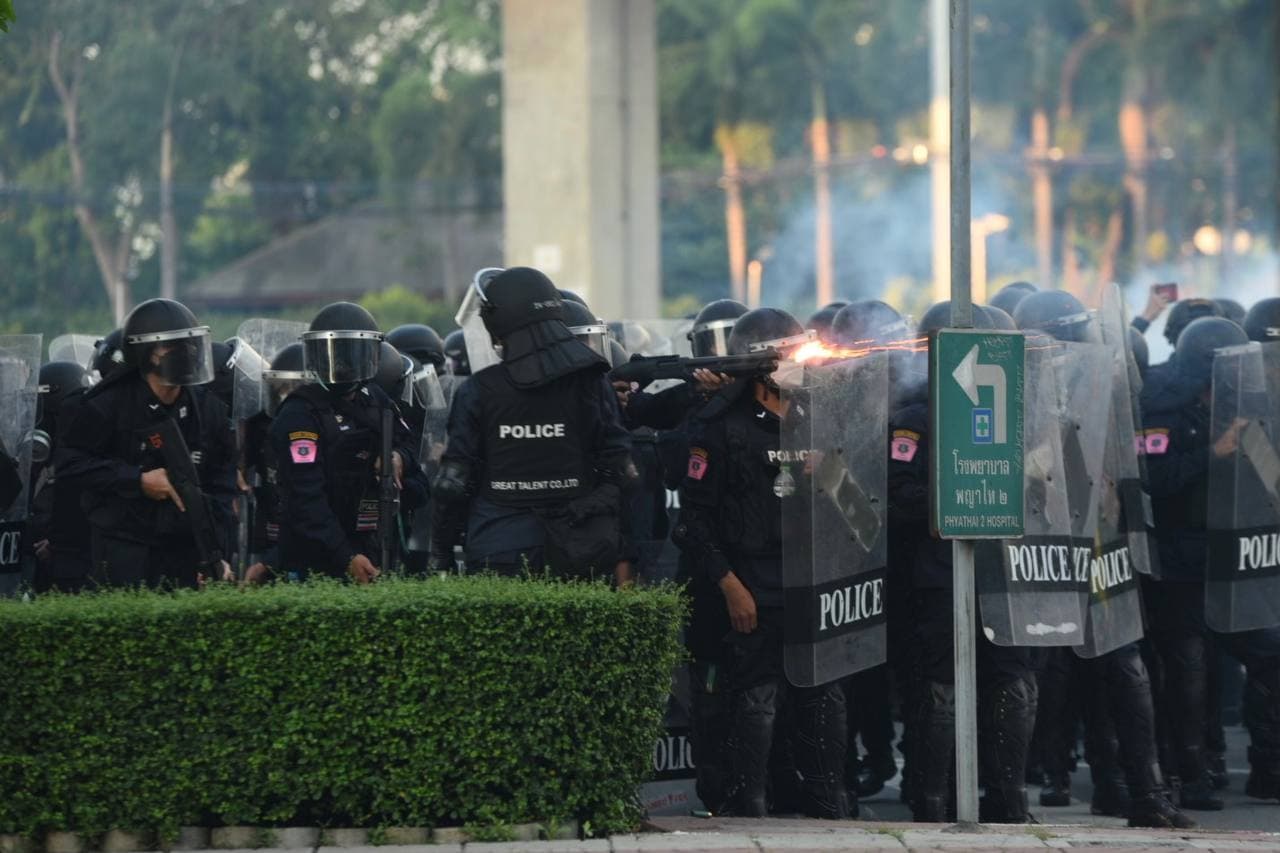
The dispersal of the Thalugas group's rally on 22 August 2021 at Din Daeng Intersection, Bangkok. Photo by Mob Data Thailand
As to the use of force to carry out the arrests, according to the General Comment no. 37, it clearly stipulates that law enforcement officials may not use greater force than is proportionate to the legitimate objective of either dispersing an assembly, preventing a crime or effecting or assisting in the lawful arrest of offenders or suspected offenders. Domestic law must not grant officials largely unrestricted powers, for example to use ”force” or ”all necessary force” to disperse assemblies, or simply to ”shoot for the legs”.
Nevertheless, AIT has been unanimously informed by the arrestees that the crowd control officials have used force to arrest the participants and non-participants without adhering to the requirements regarding necessity and proportionate use of force. This has led to a number of injures including among children and youth. Meaning the arresting officials have failed to act in compliance with the due process of law including not identifying oneself as competent officials who have power to arrest or power to assist with the arrest. They might not even identify themselves as police officials as well. Non-participants have also been arrested including a food delivery rider, a messenger, and those venturing out of their home to buy food during the curfew time. The officials justified the use of force to carry out the arrest by simply claiming that the arrestees have committed flagrant offences. The Royal Thai Police’s statements tend to justify the use of force by claiming the arrestees were absconding even there have been no other reports or information attesting to any attempt to resist which might prompt the officials with more people and weapons to have to use force to execute the arrests.
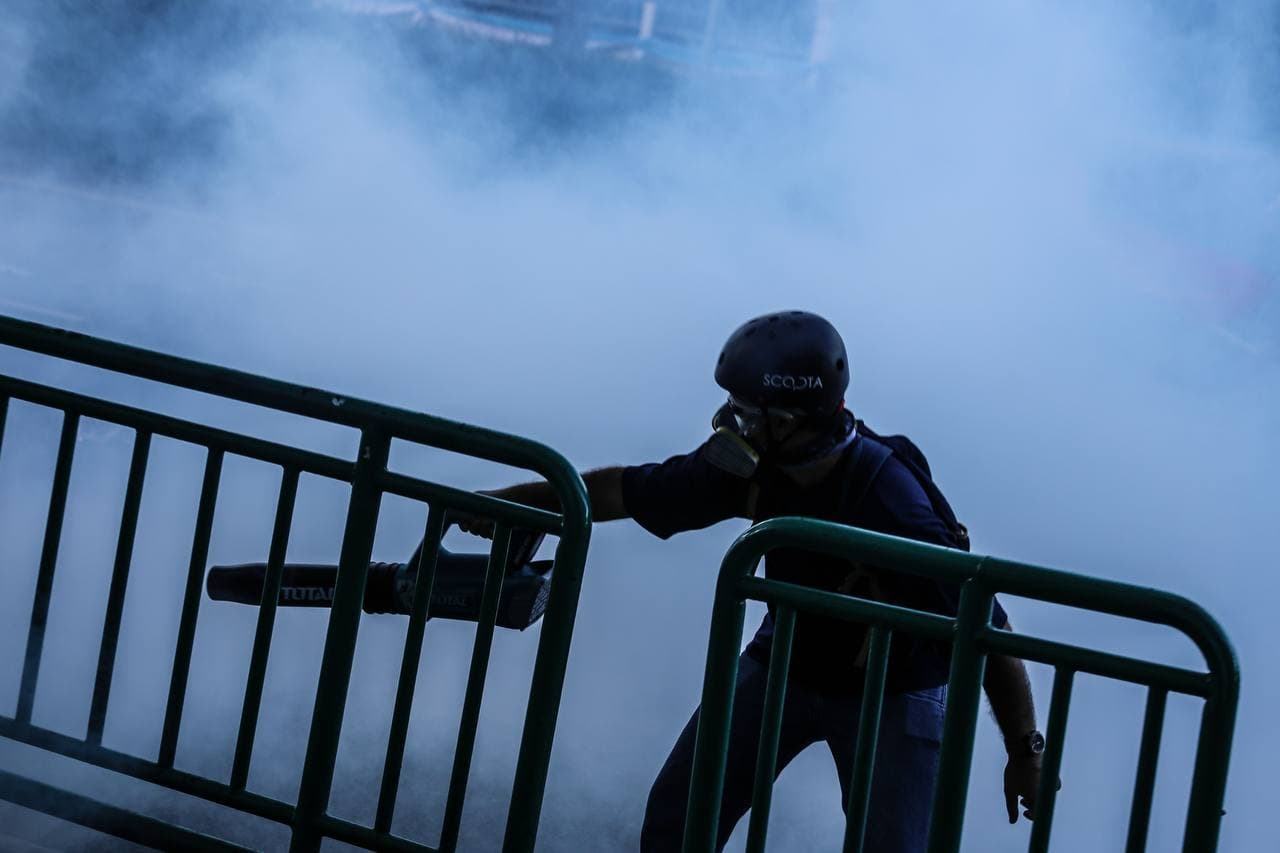
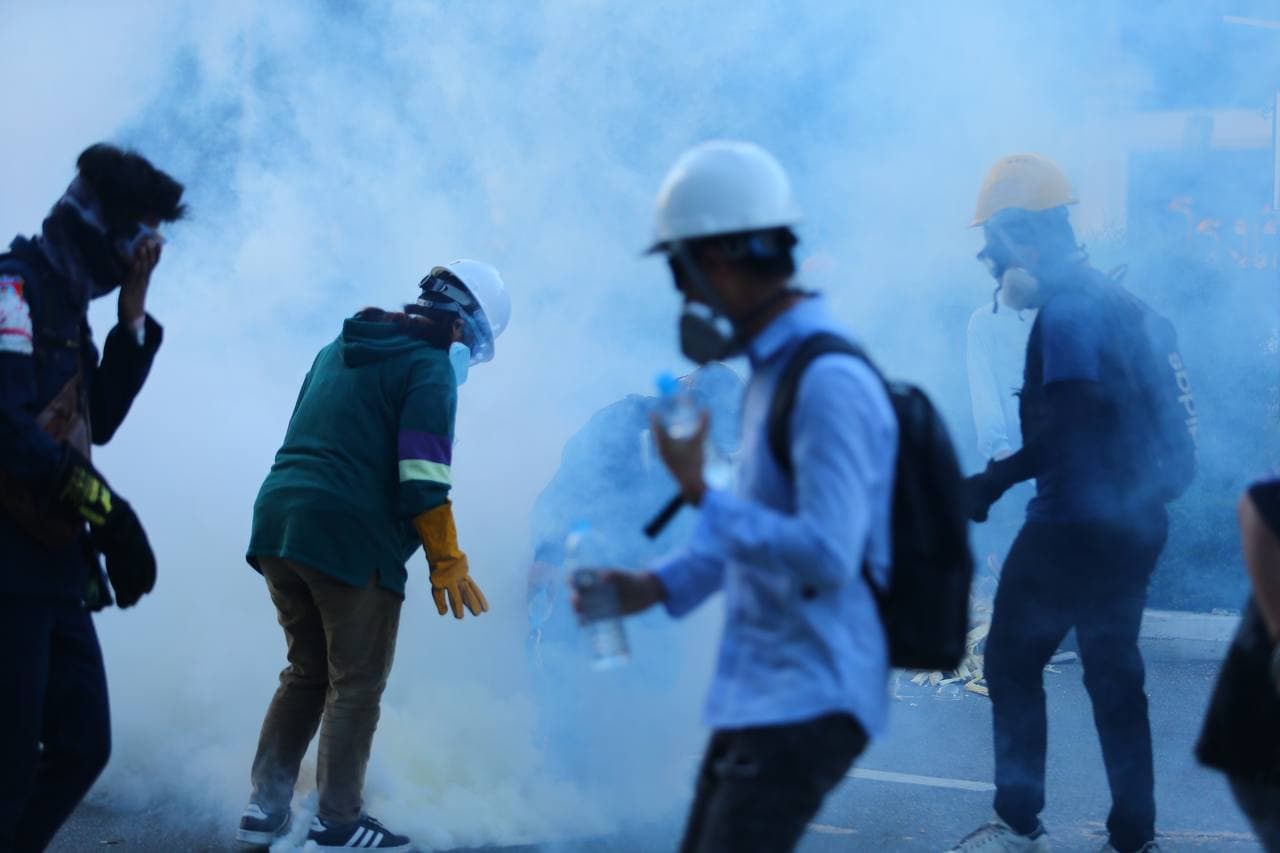
The dispersal of the public assembly organized by the Thalu Fah group on 16 August 2021 at the Victory Monument, Bangkok. Photo by Mob Data Thailand.
The use of force during the arrests against individuals believed by the officials to have participated in the public assemblies and description of the injuries resulting from the forceful arrests can be made as follows;
Upper body Wounds around neck sustained during the arrest, contused wounds on chest and fingers, being harshly pulled by arm causing abrasive wounders on wrists and small buts under right elbow, having both arms restrained from behind and being electrocuted with truncheon in low voltage, being hit by truncheon, being pressed on neck and back to lay on the ground, being forced to lay down on the ground and having both hands tied in the back, being kicked in chest, having hands restrained by cable tires, sustaining abrasive wounds and pain, being stamped by feet in the back, being kicked in the face and neck until passing out, being kicked in the left ribs, being hit on the occipital. Most victims of violence sustained wounds on their faces, backs, hands, around their eyes, etc.
Lower body Being stamped on right foot and sustaining abrasive wound on left lower leg and another wound on ankle
Injuries sustained when officials attempting to make arrest, causing motorcycles to skid At least four of them, all were children and youth.
Being hit with rubber bullets in cheek, armpit, and shoulder, at least eight of them
Have other weapons been used such as firearms and live bullets?
On 16 August 2021, apart from the arrests of 13 participants including five youth, it has been reported and could be verified that later that at least three youth got injured from live bullets at the Samliam Din Daeng Intersection and on the way to the Din Daeng Police Station. A 15-year-old-boy was shot with a live bullet which is still lodged in brain stem. At present, he no longer responds to the treatment. Another 14-year-old-boy was hit with a live bullet that penetrated his shoulder. Another youth who was just X years old, was hit at his foot and after receiving treatment, he was able to return home. Nevertheless, the police and the Royal Thai Police claimed no live bullets were used against the participants, even though photos have been circulated widely via online media showing the person who appeared to shoot a firearm from the Din Daeng Police Station on the day of the incidence. After reviewing initial evidence, the police explained that the incidence was caused during an altercation among the young people and denied that the officials have fired such shots. Nevertheless, families of both victims insisted that both of them had no obvious foes. It was the first time that the 15-year-old-boy has participated in a public assembly, and he has had no failing-out with anyone. Their families have reported the cases to the inquiry officials at the Din Daeng Police Station demanding the police to bring the perpetrators to justice.
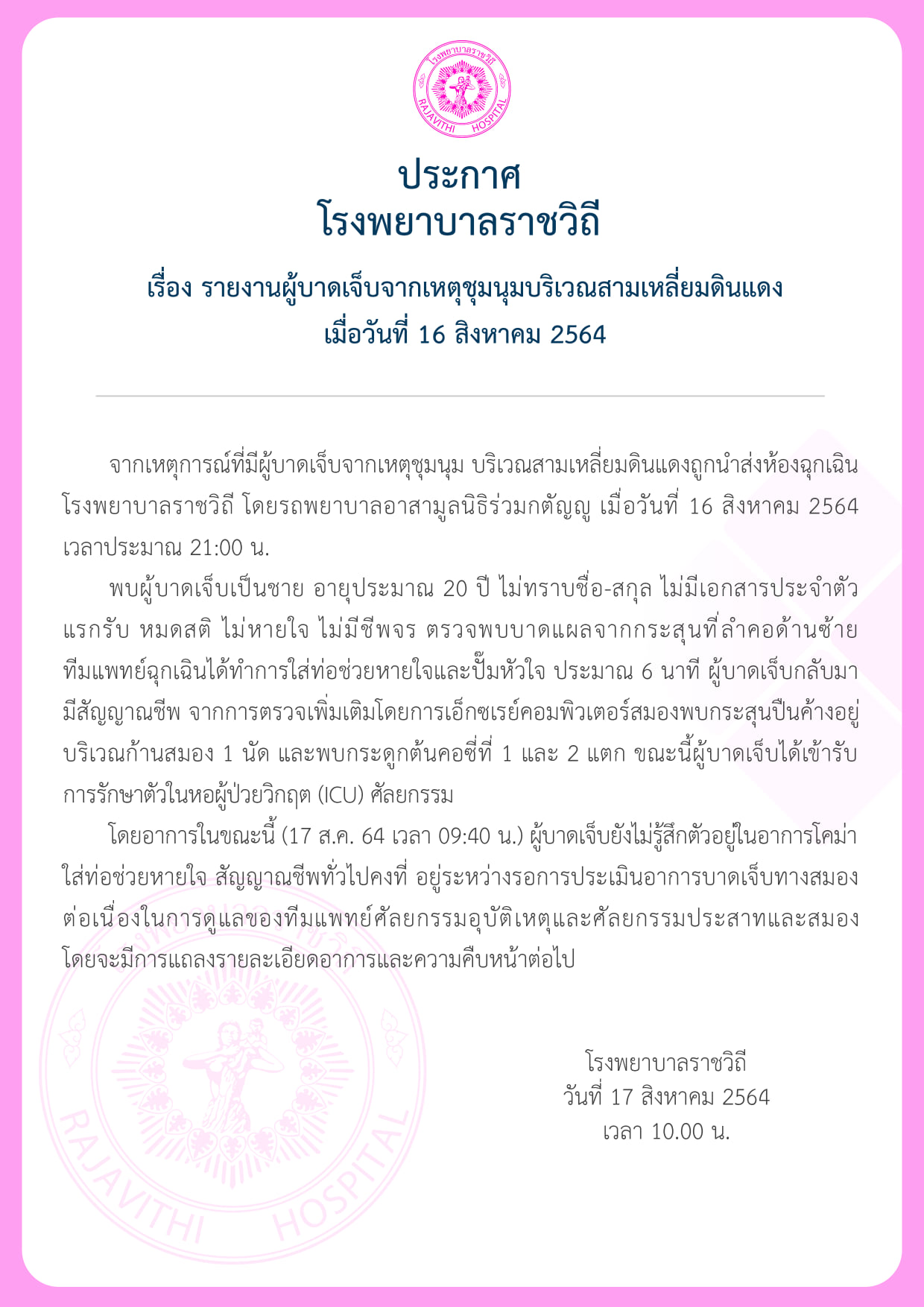
Announcement of injured from the dispersal of the rally on 16 August 2021. Photo by Rajavithi Hospital Department of Medical Services
In addition, Thai Lawyers for Human Rights (TLHR) further reports that an attempt has been made by the police and inquiry officials to interview the 14-year-old-boy who was receiving the treatment in hospital without his attorneys and without multidisciplinary team. Nevertheless, the nurses refused to let the police conduct such interview.
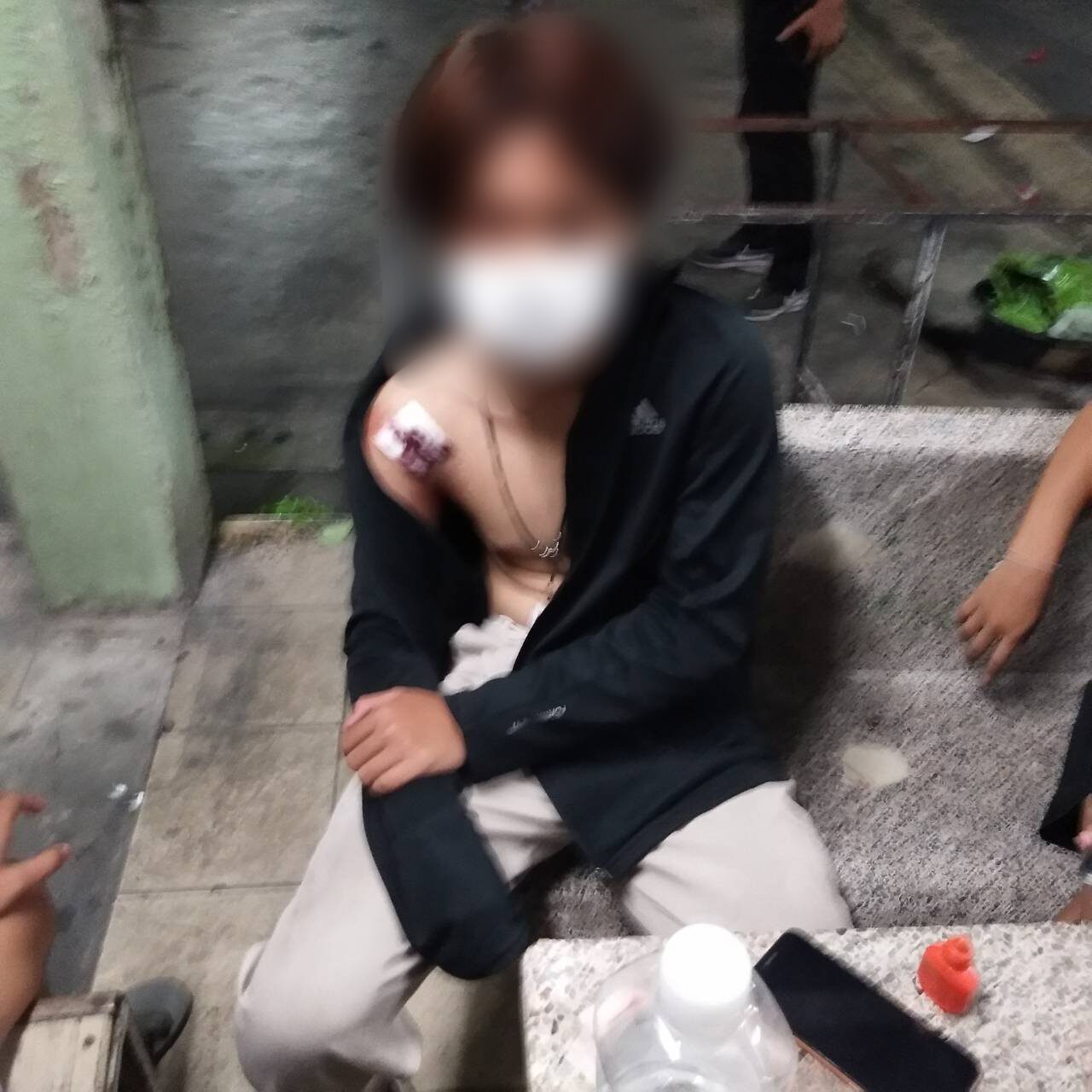
14-year-old-boy was hit with a live bullet that penetrated his shoulder during the dispersal of the public assembly organized by the Thalu Fah group on 16 August 2021 at the Victory Monument, Bangkok. Photo by Matichon Online
How the officials respond to children and youth in the protesting site
Has there been an attempt to isolate or take care of children and youth in the protesting site? If not, please explain how the officials treat children and youth present in the protest
As a general rule for the execution of duties and the exercise of force by officials to facilitate the activities by the participants should only be made by the officials who have received training on crowd control. Such training should sensitize officials to the specific needs of individuals or groups in situations of vulnerability, which may in some cases include women, children and persons with disabilities, when participating in peaceful assemblies.
Nevertheless, AIT has found no special measures have been adopted to facilitate and protect children and youth participating in a peaceful public assembly. On the contrary, children and youth have often been viewed as people who have caused turbulence, particularly at the Samliam Din Daeng Intersection. From 7 August 2021 until 22 August 2021. 16 children and youth, one of whom was only 13 have been arrested from participating in the public assemblies in the area. The police only said that the 13-year-old boy ‘fell from motorcycle’ and was receiving treatment at the Police General Hospital. It is unclear of the child was charged later on. This indicates that in practicality and in principle, the authorities have adopted no special measures to help the children and youth to exercise their right to freedom of peaceful assembly even though the right to freedom of public assembly and expression is a guaranteed right for children and youth. It is a right that has to be protected, upheld, and promoted according to the International Covenant on Civil and Political Rights (ICCPR) and the UN Convention on the Rights of the Child.
If children or youth were held in custody, please indicate the measures adopted by the officials when carrying out the arrests. Have there been children or youth who got injured during the arrest? Explain in brief the charges against them, the detention facilities, other rights of the child including the right to meet with their parents, the right to medical treatment and the right to meet with their legal counsel
As mentioned above, during 16-22 August 2021, a large number of children and youth were arrested. A number of them, albeit not arrested, have sustained injuries from participating in the public assemblies. We do not know the exact number since the authorities do not collect segregated data of the persons injured during the public assemblies. This is a contravention of the UN Human Rights Committee’s General Comment no 37 which prescribes that all use of force by law enforcement officials should be recorded and reflected promptly in a transparent report. Where injury or damage occurs, the report should contain sufficient information to establish whether the use of force was necessary and proportionate by setting out the details of the incident, including the reasons for the use of force, its effectiveness and the consequences of it.
According TLHR, Child in Mob and Mob Data Thailand, as many as 48 children and youth have been arrested, mostly from the public assemblies at the Samliam Din Daeng Intersection. Amnesty International Thailand has found all of them were arrested without warrants (as the police claimed they have committed flagrant offences). During the arrests, the officials used force and some of them were handcuffed or had their hands restrained with cable tires. In addition, if they sustained injuries, they would not be sent for treatment immediately. Rather, they would be brought to the Narcotics Suppression Bureau. In most cases, the children and youth would have their mobile phones seized, and some even have their motorcycles seized as well. The attorneys were allowed to meet with the arrestees including youth, only after their arrest reports have been completed. It turned out later that in some cases, it mentions in the arrest reports that the children and youth have pleaded guilty to the charges. This happened since many arrests took place at nighttime and the children and youth were unable to meet their parents in time. Meanwhile, the attorneys were not allowed to meet with the children before arrest reports have been prepared. After that, the police would have them answer to the changes during the nights and brought them for an arraignment at the Central Juvenile and Family Court the following morning.
Detail of the arrests, detentions and the right to medical treatment and timely access to attorneys can be described as follows;
On 16 August 2021, of 16 arrestees, five were children and youth who were physically abused during the arrests including being strangled. One person sustained contused wounds during the arrest in his chest and fingers. Some have their motorcycles and mobile phones seized by either the crowd control officials or the inquiry officials.
On 20 August 2021, of 26 arrestees, 19 were children and youth. It has been reported that the children and youth were physically abused during the arrests being pressed on their heads and backs to lay flat on the ground causing abrasive and swelling wounds. One youth said he was stamped on his back by the officials and another one was shot with rubber bullets. The rest were violently grabbed by their collars, having their arms restrained, being threatened. Two youth were handcuffed together. Another two children were hit with rubber bullets in their cheek and leg, respectively, and they needed to have an operation to remove the rubber bullets. The doctor did not allow them to return home and asked them to stay for further treatment at the hospital. TLHR further reports that the attorneys and their families are still not allowed to visit them.
On 21 August 2021, of seven arrestees, two were children and youth who were physically abused during the arrests. Both were kicked in their occipitals and backs and had their hands restrained with cable tires in their back causing pain on their knees and necks. They were kicked in their chest and shoulder causing confusion as well.
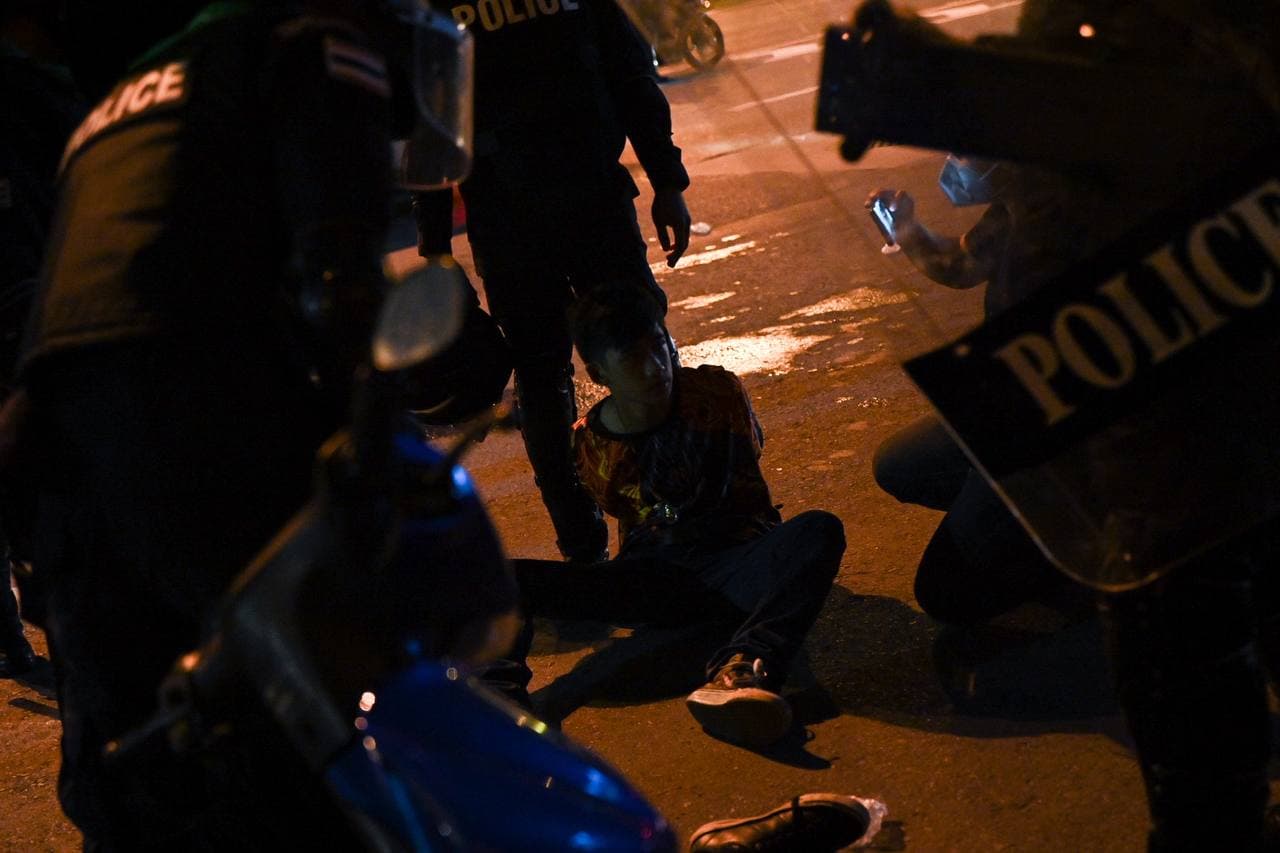
The dispersal of the Thalugas group's rally on 21 August 2021 at Din Daeng Intersection, Bangkok. Photo by Mob Data Thailand
On 22 August 2021, of 22 arrestees, 19 were children and youth. It has been reported that the officials have used force to arrest and hold 16 children and youth in custody at the Phahonyothin Police Station. In addition, it was found the children and youth had their hands restrained with cable tires for a long time and they were not released from their custody until 23.00. At least six children and youth have sustained injuries from the use of force by the officials including twisted elbow (the child was later sent to the Police General Hospital for treatment around 03.30). They sustained abrasive wounds on their arms, legs, torsos, and backs. Photo evidence shows at least two children and youth were injured by rubber bullets. In addition, one female youth was charged for having in possession explosive-like articles and another 13-year-old girl was injured from falling off her motorcycle and was sent for medical treatment at the Police General Hospital.

The dispersal of the Thalugas group's rally on 22 August 2021 at Din Daeng Intersection, Bangkok. Photo by Dailynews
Treatment of the Juvenile and Family Court (if any), i.e., the amount required to post bail, etc.
According to safeguards in the criminal justice process to protect the rights of persons in custody, it requires that the person under arrest be brought to the court at the first possible opportunity. The Juvenile and Family Court and Juvenile and Family Case Procedure Act 2010 requires such children or youth under arrest be brought for a review at the court within 24 hours after the arrest. Nevertheless, such requirement does not lead to the protection of the child arrestees since the court only starts counting from the time when the children and youth met with the inquiry officials. They do not count the time when the children or youth were arrested by the crowd control officials from the protest sites even though during that time at least five children and youth were subject to physical assault or sustained injury from rubber bullets and tear gas. The court has so far ruled the arrests in such circumstances have been carried out lawfully according to Section 72 of the Juvenile and Family Court and Juvenile and Family Case Procedure Act.
Even individuals alleged to have violated the Emergency Decree on Public Administration in the State of Emergency have often been granted bail by own recognizance. But in the case of one juvenile charged for having in possession explosive-like articles on 22 August 2021, the court requires him to post bail with 20,000 baht. In addition, the inquiry officials should use their discretion to grant bail pending the investigation. But, in reality, the inquiry officials have never used their discretionary power even though it could be verified later on that some youth had never participated in the public assemblies, but they were arrested. The inquiry officials would bring all of them to the Juvenile and Family Court to request for remand in custody in all cases.
Treatment of authorities toward the press and monitors during public assemblies
Policies-statements by the Royal Thai Police and the Metropolitan Police Bureau (if any) concerning the press’s activity
The Royal Thai Police emphasized that media should always wear armbands with the press symbol while in the protest sites showing they are performing their press duties. They even mark the spots from which the media should stay to livestream and report their news, i.e., only behind the police line claiming that it is for safety of the media themselves. The officials may also conduct a search and ask for press cards, and with such cards, the persons could be arrested just like the participants.

